Stuff:Votorola/a/M2:Maximizing personal freedom
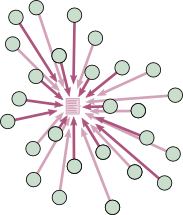 |
| (M2) | Morality promotes a maximum of personal freedom compatible with equal freedoms for all. |
|---|---|
| (D) | Just those action norms are valid to which all possibly affected persons could agree as participants in rational discourses.2 |
The technical goal is to compose consensus norms (D) while simultaneously accommodating a maximum of personal freedom (M2).3 Therefore we must reject the usual method of consensus composition on the ground that it limits free expression. No author can express herself freely through a draft text while 25 others (to say nothing of 25,000) likewise attempt to express themselves through the same draft (figure UM). If that is the whole of the solution, as it is with wikis, then we must look elsewhere for a better design. We need not look far, however, because the determinant of freedom in this case is obvious: every author must be allowed a draft of the text that is independent of, and formally equal to every other.
The corresponding determinant of consensus, then, is equally obvious: all authors must be able to remove unwanted differences between their drafts. In practice, this means copying sequences of text from draft to draft. Together these two facilities of independent authorship (left of figure i1) and peer-to-peer transfers of text (right) are characteristic of a pattern of composition known as 'recombinant text'.4
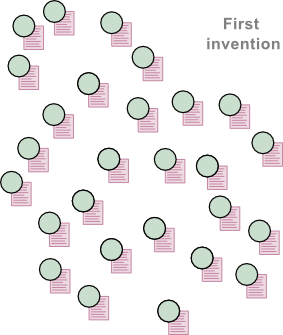 |
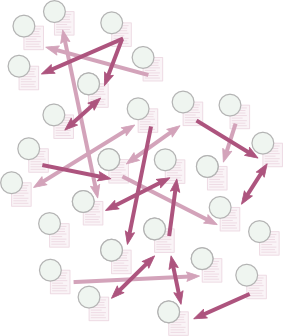 |
But while the recombinant transfers on the right of the figure imply a potential for reaching agreement (as indeed a particular pair-wise difference is eliminated with each transfer) nothing indicates the actual, overall extent of agreement. A recombinant text allows for, but cannot in itself formalize and express a consensus. For that, we must introduce a voting method. We must be careful in the choice, however, because the conventional methods are all designed for mass voting, which means a relatively small number of candidates. And mass patterns of communication often sit poorly with peer-to-peer. In this case, the network effects of mass voting would soon collapse the complex, open structure of the recombinant text onto a relatively small number of candidate drafts, eventually reducing it to the imploded star pattern of figure UM, with its unacceptable disregard of free expression.
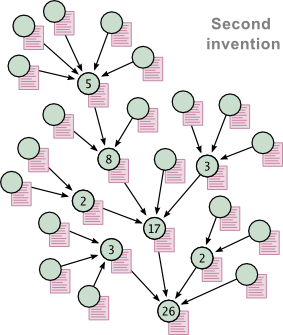 |
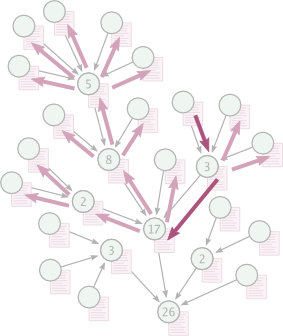 |
Free expression is better upheld by transitive voting 5 — although it does leave one problem unsolved. Both the solution and the unsolved problem are visible in figure i2. On the solution side, transitive voting facilitates a consensus without systematically forcing it. All authors and other persons are eligible to receive votes. Votes received are carried along with one's own vote wherever it goes; together they cascade like raindrops down the branches of a tree. The crucial thing to understand is that freedom of expression applies not only to text changes, but also to vote changes; one may shift one's vote without restriction, or withdraw it at any time. So now we have two formal freedoms to uphold for each person.
 |
The problem remaining to solve is that both of these freedoms are likely to be forfeited, in practice, by persons who receive votes (candidates). A candidate who speaks for her voters no longer speaks for herself. As her personal draft is now a group draft, and her personal vote a group vote, she has lost all formal means of individual expression. This is most apparent for a major delegate (e.g. 17, figure above) or a root candidate (26). Her responsibility to her voters weighs on her actions and ties her to a position that is not properly her own. To be sure, a similar loss will affect the entire forest, as even leaf situated authors will tend to assume the role of vote attractors, and, in anticipation of becoming candidates, surrender their freedom of expression to that end. A mechanism that demands such a sacrifice is not yet a complete solution. Something is missing.
Apparently the task remaining is to decouple the roles of candidate and person, and so (once again) free the person. We can accomplish this by using a device known as a 'pipe'.6 A pipe is an impersonal surrogate controlled by a pipe minder, appointed in turn by the pipe's immediate voters. Each pipe carries votes like a delegate, but its own vote never counts. So it represents a group, or other association of persons, without also representing a person. The liberating effect of pipes is illustrated in figure i3, where they are introduced among the internal candidate positions (hollow circles), consequently freeing the persons of those candidates to move outward to leaf positions in the canopy (faded green discs). Even the person of the root candidate is now able to cast a vote of her own. This explains why the vote flow to the root has now increased from 26 to 27. Complete voting freedom is thus restored; all persons are now able to participate as leaf voters, each freely shifting his or her vote to settle on whatever branch or tree suits the moment.
Complete editorial freedom is also restored. In this case, note how the two, seemingly incompatible requirements of theory are met. On one hand, the relatively constrained text flows required to maintain consensus (D), which we therefore drew in figure i2, may now be reproduced within the piped, internal structure of i3. On the other hand, the unrestricted flows required to maintain personal freedom (M2), which we therefore drew in figure i1, may now reappear externally among the leaves of i3. For this, imagine looking down on the outer, leafy surface of i3, and there seeing the criss-cross text flows of i1.
Addenda
Property settings
- Issue type (Category:Law (implicit)) 7
- Issue type (Category:Myth (implicit)) 7
- Issue type (Category:Plan (implicit)) 7
- Issue type (Category:Budget (implicit)) 7
- Place (Stuff:Guideway) 8
- Purpose (Stuff:Votorola/p)
Notes
- ^ a b The present text is modified from a (2014) submission to an essay contest. http://fqxi.org/community/forum/topic/2041
- ^ Jürgen Habermas. 1992. Between Facts and Norms: Contributions to a Discourse Theory of Law and Democracy. Translated by William Rehg, 1996. MIT Press, Cambridge, Massachusetts. p. 107.
- ^ Note that 'consensus' means general agreement, which may be less than unanimity.
- ^ Recombinant text was described by Michael Allan. 2005. http://reluk.ca/project/textbender/
- ^ A limited form of transitive voting (single step) was described by Charles L. Dodgson (Lewis Carroll), 1884. The Principles of Parliamentary Representation. Harrison and Sons, London. pp. 36-40.
The form outlined here, married with recombinant text, was previously described by Michael Allan, 2008. A medium of assent and its fit with society. The ITP News: Newsletter of the Information Technology and Politics Section, American Political Science Association. 4:2, pp. 12–13.
- ^ The concept of pipes as impersonal surrogates originates with Thomas von der Elbe, 2012. http://mail.zelea.com/list/votorola/2012-June/001380.html For more information, see Category:Pipe.
- ^ a b c d This page concerns text form, normative issues in general.
- ^ This page concerns text based, norm guideways in general.